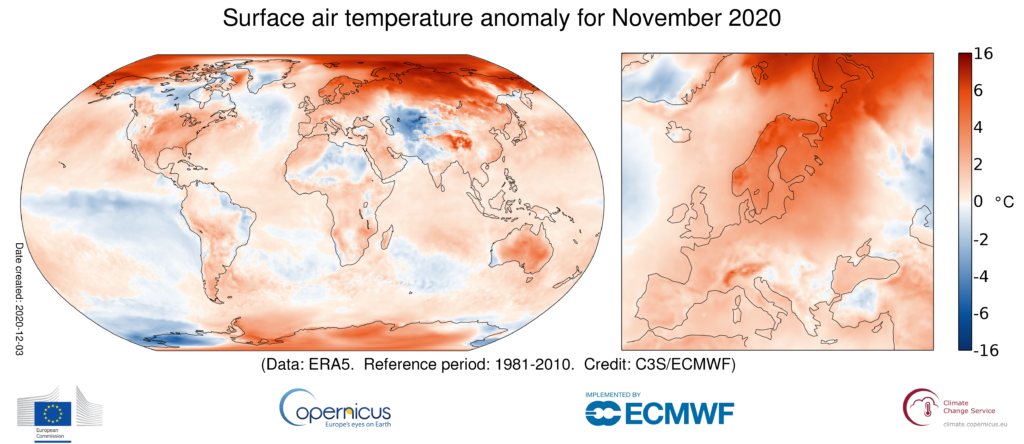Global November temperatures reached a record high in 2020 – Europe experienced its warmest autumn on record

7 December 2020 (Copernicus Climate Change Service) – The Copernicus Climate Change Service (C3S), implemented by the European Centre for Medium-Range Weather Forecasts (ECMWF) on behalf of the European Commission, announced today that global average temperatures in November 2020 were the highest recorded for the month by a clear margin in the C3S data set. Reanalysis data show that November was close to 0.8°C above the standard 30-year reference period of 1981-2010, more than 0.1°C above the previous warmest Novembers of 2016 and 2019. Temperatures were most above average over a large region covering much of northern Europe, Siberia, and the Arctic Ocean. Substantially higher than average temperatures also occurred over parts of the USA, South America, southern Africa, over the Tibetan Plateau, eastern Antarctica, and most of Australia.
In Europe, November 2020 temperatures were particularly high, making it the joint second warmest November with 2009, 0.2°C below the temperature for November 2015. In contrast, temperatures were most below average over central Asia and western Antarctica.
In addition, C3S reports that average autumn temperatures in Europe were higher than any autumn on record. For boreal autumn 2020 (September, October and November), European temperatures were 1.9°C above the standard reference period, 0.4°C higher than the average temperature in 2006, which was previously the warmest autumn. Most of Europe saw above average temperatures, and they were particularly warm over the northern and eastern parts of the continent.
The Arctic region and large parts of northern Siberia have seen temperatures substantially above average throughout 2020, not just during boreal autumn and November. Sea ice cover in the same region, has been particularly low since the beginning of summer. C3S data show that Arctic sea ice extent reached its second lowest November value since the beginning of satellite observations in 1979.
With just one month left of the year, C3S data for the year to date show that 2020 is currently on a par with 2016, the warmest calendar year on record, closely followed by 2019. Based on data from several global datasets and including data up until October, the WMO announced last week that 2020 is set to become one of the three warmest years on record. The addition of one more month of data from C3S shows that 2020 is now even closer to the 2016 record. The calendar year of 2020 as a whole is likely to remain on a par with or become marginally warmer than 2016 unless the global temperature anomaly falls significantly from November to December, which would not be unprecedented.

For Europe, 2020 is 0.5°C warmer than the January – November period for 2019, the warmest calendar year on record, and at least 0.4°C warmer than the same period in any other year in the C3S dataset. It is almost certain that 2020 will become the warmest calendar year for Europe as a whole.
Carlo Buontempo, Director of the Copernicus Climate Change Service at ECMWF, comments: “Globally, November was an exceptionally warm month compared to other Novembers, and temperatures in the Arctic and northern Siberia remained consistently high, with sea ice at its second lowest extent. This trend is concerning and highlights the importance of comprehensive monitoring of the Arctic, as it is warming faster than the rest of the world.”
“These records are consistent with the long-term warming trend of the global climate. All policy-makers who prioritise mitigating climate risks, should see these records as alarm bells and consider more seriously than ever how to best comply with the international commitments set out in the 2015 Paris Agreement”, he adds.
Monthly Temperature Summaries from the Copernicus Climate Change Service (C3S)
C3S publishes monthly climate bulletins reporting on the changes observed in global surface air temperature and other climate variables. All the reported findings are based on computer-generated analyses using billions of measurements from satellites, ships, aircraft and weather stations around the world.
November 2020 surface air temperature:
- Globally, November 2020 was the warmest November on record, by a clear margin
- For Europe, the month was the joint second warmest on record
- Temperatures were most above the 1981-2010 average over a large region covering much of northern Europe, Siberia and the Arctic Ocean
- Temperatures were most below average over central Asia and West Antarctica
November 2020 sea ice:
- Arctic sea ice extent was the second lowest for November in the satellite data record, beginning in 1979
- Sea ice concentrations were most below average in the Kara and northern Barents Seas
- Antarctic sea ice extent was close to average, but with large spatial differences around the continent
Boreal autumn 2020 surface air temperature:
- Europe as a whole experienced its warmest autumn on record, with temperatures most above average in the north and east
- The main regions of above and below average temperatures globally were similar to those for November
The map and quoted data values are from ECMWF Copernicus Climate Change Service’s ERA5 dataset, currently dating back to 1979. Area averages for temperature over the European region are for land only with the following longitude/latitude bounds: 25W-40E, 34N-72N.
More information about climate variables in November and climate updates of previous months as well as high-resolution graphics can be downloaded here:
https://climate.copernicus.eu/monthly-climate-bulletins
More information about the C3S data set and how it is compiled can be found here:
https://climate.copernicus.eu/climate-bulletin-about-data-and-analysis
Contact
- NURIA LOPEZ, Press Lead and Communication Account Officer, ECMWF Copernicus Services Communication European Centre for Medium-Range Weather Forecasts (ECMWF), Shinfield, Reading | Bologna, Italy, Email: copernicus-press@ecmwf.int



One Response
Comments are closed.